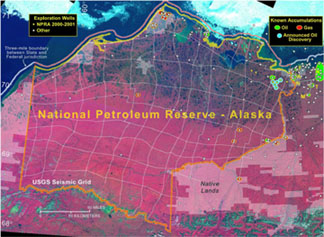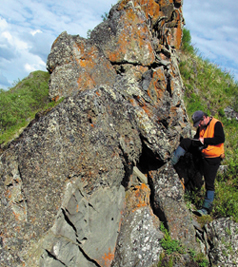Geotimes

News Notes
Petroleum
geology
Big oil
numbers for Alaska
A version of this story first appeared on May 17 as a Web Extra, New
oil numbers for Alaska.
The National Petroleum Reserve in Alaska (NPRA) holds substantially greater oil
resources than previous estimates, according to a U.S. Geological Survey (USGS)
assessment released in May. The assessment came just in time for the leasing of
NPRA land on June 3. It also follows on the heels of a heated energy debate this
spring, when the Senate voted against opening the Arctic National Wildlife Refuge
(ANWR) to oil drilling. Congress is now in conference to draft a compromise energy
bill. The Bush administration has been looking to expand exploration of domestic
petroleum resources, particularly on Alaska’s North Slope. With the administration
hoping to open an additional 9.4 million acres of the petroleum reserve to oil
and gas leasing in 2004, the latest USGS results are sure to cause a stir on the
Hill.
The numbers
 In this
first assessment of the area since 1980, USGS scientists report that between
5.9 and 13.2 billion barrels of oil are technically recoverable in the 22.5-million-acre
federal lands of NPRA, with a mean value of 9.3 billion barrels — more
than four times the mean value of the previous estimate. For the entire NPRA,
including state offshore areas and Native American lands, the mean estimate
is 10.4 billion barrels.
In this
first assessment of the area since 1980, USGS scientists report that between
5.9 and 13.2 billion barrels of oil are technically recoverable in the 22.5-million-acre
federal lands of NPRA, with a mean value of 9.3 billion barrels — more
than four times the mean value of the previous estimate. For the entire NPRA,
including state offshore areas and Native American lands, the mean estimate
is 10.4 billion barrels.
This Landsat image map shows the
locations of exploration wells and known accumulations in NPRA, along with the
seismic grid used in the 2002 assessment. Read the USGS report for a more detailed
map description.
By comparison, a 1998 USGS assessment of oil and gas resources in ANWR estimated
that between 4.3 and 11.8 billion barrels for oil are technically recoverable
in the 1.5-million-acre, federally owned lands (the so-called 1002 area). The
mean value was 7.7 billion barrels. Most of the economically recoverable oil
lies to the west of the Marsh Creek Anticline in the undeformed region closest
to the areas of current oil development in Prudhoe Bay.
According to the 2002 assessment for NPRA, an estimated 1.3 to 5.6 billion barrels
of oil are economically recoverable in NPRA at market prices of $22 and $30
per barrel, respectively. In ANWR, however, in the same price range, those estimates
jump to between 4.4 and 5.8 billion barrels, because ANWR covers a smaller area
and contains larger accumulations — making it easier to develop the area.
At a market price of $35 or higher, however, the number of barrels of economically
recoverable oil in NPRA and ANWR about equal one another.
Approximately 80 percent of the technically recoverable oil occurs in the northern
third of NPRA. And the report estimates oil accumulations of moderate sizes,
around 30 to 250 million barrels each, significantly smaller than those found
in currently developed Prudhoe Bay and smaller on average than those in ANWR.
The oil in the petroleum reserve lies in reservoirs only about 50 feet thick,
stretched across an area 300 miles wide and 200 miles from the coast inland
to the Brooks Range. In ANWR, the oil is largely concentrated in reservoirs
as thick as 300 feet.
Geological surprises
Exploration wells previously drilled in NPRA and in adjacent state and federal
waters showed that the area is geologically different from Prudhoe. The petroleum
plays with the most potential are westward continuations of the geologic trends
that host petroleum plays east of NPRA — the Alpine Fiord, Tarn, Meltwater
and Nanuq oil pools.
 Data from industry
wells from the Alpine oil discovery played a significant role in the revised
estimates, says David Houseknecht, a USGS senior geologist and co-author of
the 2002 assessment. “Even ARCO, when they drilled a discovery well, did
not know that reservoir existed. In fact they were drilling to test a shallower
prospect that was a failure, and they took the well on down, and there were
three big surprises they didn’t know about previously,” Houseknecht
explains.
Data from industry
wells from the Alpine oil discovery played a significant role in the revised
estimates, says David Houseknecht, a USGS senior geologist and co-author of
the 2002 assessment. “Even ARCO, when they drilled a discovery well, did
not know that reservoir existed. In fact they were drilling to test a shallower
prospect that was a failure, and they took the well on down, and there were
three big surprises they didn’t know about previously,” Houseknecht
explains.
Chris Schenk, a research geologist with
the USGS in Denver, describes soil conglomerates in the Cobblestone Sandstone
Member of the Fortress Mountain Formation which is located in the Brooks Range
Foothills, southeast of the National Petroleum Reserve-Alaska. Photo by David
Houseknecht
The formation contained beach-type sand with a separation of fine and coarse
particles (winnowed) and a kind of stratigraphic trap previously unknown in
that area. Additionally, the oil was high gravity, meaning that the oil flows
easily.
Previous data had shown clay-rich formations with fine-grained sands and lower
gravity oil, like in Prudhoe Bay — making the formation not viable as stand-alone
accumulations. But the 2002 NPRA assessment shows otherwise. “The surprise
in Alpine was that not only was there this beautiful well-winnowed shore face
sand but it was full of oil that flows like water,” Houseknecht says.
Geologically, the NPRA formations also differ greatly from those in ANWR, where
the biggest resources estimated are in growth-fault rollover features that look
similar to the Texas Gulf Coast, he adds.
This latest USGS study did not incorporate 3-D seismic surveys or new wells
drilled in NPRA since 1999. It does include estimates of natural gas for the
NPRA area. Visit www.geotimes.org for more, including maps and a link to the
online report.
Lisa M. Pinsker
Links:
USGS site, where you can download
the report and high resolution images
Special June Resources story about ANWR
 In this
first assessment of the area since 1980, USGS scientists report that between
5.9 and 13.2 billion barrels of oil are technically recoverable in the 22.5-million-acre
federal lands of NPRA, with a mean value of 9.3 billion barrels — more
than four times the mean value of the previous estimate. For the entire NPRA,
including state offshore areas and Native American lands, the mean estimate
is 10.4 billion barrels.
In this
first assessment of the area since 1980, USGS scientists report that between
5.9 and 13.2 billion barrels of oil are technically recoverable in the 22.5-million-acre
federal lands of NPRA, with a mean value of 9.3 billion barrels — more
than four times the mean value of the previous estimate. For the entire NPRA,
including state offshore areas and Native American lands, the mean estimate
is 10.4 billion barrels. 
 Data from industry
wells from the Alpine oil discovery played a significant role in the revised
estimates, says David Houseknecht, a USGS senior geologist and co-author of
the 2002 assessment. “Even ARCO, when they drilled a discovery well, did
not know that reservoir existed. In fact they were drilling to test a shallower
prospect that was a failure, and they took the well on down, and there were
three big surprises they didn’t know about previously,” Houseknecht
explains.
Data from industry
wells from the Alpine oil discovery played a significant role in the revised
estimates, says David Houseknecht, a USGS senior geologist and co-author of
the 2002 assessment. “Even ARCO, when they drilled a discovery well, did
not know that reservoir existed. In fact they were drilling to test a shallower
prospect that was a failure, and they took the well on down, and there were
three big surprises they didn’t know about previously,” Houseknecht
explains. 